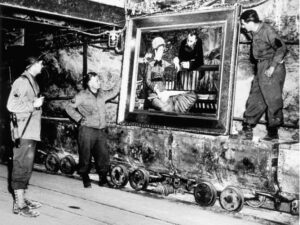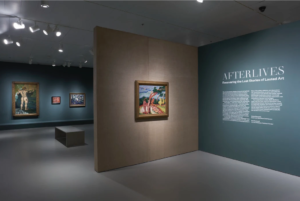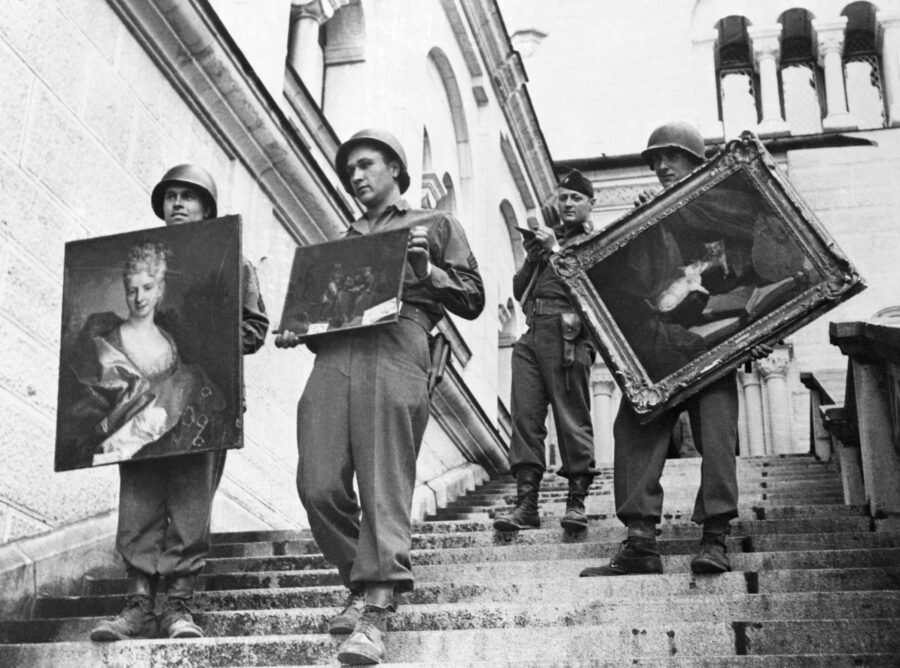1.4 Thematic Analysis: Provenance Research
Provenance research is a crucial framework used by museums, galleries and libraries to establish the full history of an object. At the most basic level, provenance relates to the origin of an object, its ownership and exchanges over time as well as the authenticity it may or may not have (Keessen, 2022, p. 118). One of the most well-researched and current examples of modern provenance research relates to Nazi-era looted art and artefacts. Under the National Socialist regime, artwork which was considered degenerate, Jewish or unaligned with the ideals of the Third Reich was confiscated and often times destroyed. Where artworks were not immediately destroyed, they were transported across Europe into various holding points. It is estimated that 650,000 works of art were looted during the Nazi era, with only 100,000 currently accounted for (Karrels, 2014, p. 297). Stolen from institutions and individual families and communities, the rampage of looting which was undertaken by the Nazis remains an ongoing effort within heritage institutions today, many of whom possess stolen art unbeknownst to them. In order to rectify this, museums and galleries are undertaking detailed provenance research in order to return stolen art to descendants of its previous owners, as well as to provide a more detailed narrative to its visiting audiences.

The Monuments Men retrieving Edward Manet’s ‘In The Conservatory’ from a salt mine in Central Germany. (Harvard Magazine , 2010, [Online]).
The guidelines established for the restitution of Nazi-era looted art are internationally known, and can be applied in the same way to the collection of human remains as seen within the University of Edinburgh’s Skull Collection. In 1998, The Washington Conference on Holocaust Era Assets was held as the first conference which approached the prospect of restitution of Nazi looted art and artefacts within institutions worldwide. The core principles adopted at the conference state that heritage institutions should be actively reviewing their possession of artworks and artefacts with unknown origins or histories of Nazi ownership. Should an institution be in possession of stolen art, it is legally responsible to return the items to their rightful owners or heirs. If restitution is not possible, then a suitable solution is to be found, such as returning an item to its country of origin or purchasing it for its current valued price (Heuberger, 2022, p. 159).
Two years after the conference, the Lost Art Database was established as a digital platform which allowed for institutions across the globe to upload information on objects they believed to have been stolen during the Nazi regime. A second, public database was released just last year titled the Nazi-Era Provenance Internet Portal. Over 100 museums have uploaded material to the portal, allowing for the public to not only understand the extent of material which was stolen by the Nazis, but also to potentially reunited works of art to living descendants (Wechsler & Ledbetter, 2004, p. 61).
Provenance research is not unique to works of art alone. Both human and artefact remains can benefit greatly from enhanced research into their origins, use and history. Considering the use of provenance research within the Skull Collection, it is clear to see how this work has the potential to bring justice to modern descendant communities. In collaboration with the University of Edinburgh, Vedda elders and Max Plank Institute for the Science of Human History in Germany, genetic testing was undertaken on the remains of a Vedda skull within the collection. The testing confirmed previous provenance research on the skull which suggested the Vedda community thrived off of a nutritional diet provided by the game in the local forests. Today, the modern Vedda are facing legal repercussions for their ancestral hunting practices, and the provenance research undertaken on the skull helps to corroborate their need for a continuation of traditional hunting technologies (The University of Edinburgh, 2021, [Online]).
Another current example of the importance of provenance research within the Skull Collection is the unification of two Sudanese descendants to members of their modern community. These skulls from Omdurman, Sudan, were only extensively researched in 2021 by Daisy Chamberlain. Chamberlain’s research discovered that the skulls belonged to individuals who resisted the British invasion of Sudan, and were eventually murdered and brought to Edinburgh by Henry Wellcome. These individuals are connected to modern descendant communities within Edinburgh today, including The Sudanese Community in Edinburgh, which is led by one of our event’s speakers, Zaki El-Salahi. When we undertake meaningful and careful research into the origins of an individual, we have the potential to reunite them with not only their communities, but also their families. While the repatriation of these skulls is still in consideration, the starting point for unification has been achieved through the successes of its provenance research. Thinking back to the use of this framework in Nazi-looted art and artefacts, it is clear to see the significance of this kind of work in regards to enacting justice and providing closure to affected individuals and groups.

Installation image from the exhibition ‘Afterlives’ at The Jewish Museum in New York City. The exhibition traces the histories of Nazi-looted art and brings forward untold Jewish narratives from the Second World War. (The Jewish Museum [Online]).
Unfortunately, it was not until the late 20th century that provenance research into Nazi-era looted art was taken seriously. It is crucial that we learn from the work that has been undertaken before us, and enact change through purposeful research as soon as possible. Two major roadblocks affected the research and return of Nazi-era artwork to its rightful owners: language barriers and a decline in the population of Holocaust survivors (Fuhrmeister & Hopp, 2019, pp. 224-226). Although many of the individuals within the Skull Collection date to the height of the British Empire in the 19th century, they are still deeply connected to many communities living in the area and abroad today.
The catalogues held within the Anatomical Museum which detail the acquisition of these skulls are written entirely in English, making it difficult for descendant communities to be involved with the research being undertaken. Moving forward, greater involvement with the affected communities needs to take place in order to secure a more well-rounded history of an individual. At our event, Face to Face, we translated our event handout into Arabic so as to assimilate information to the relevant groups in attendance, yet we recognise this is just one small step that needs to be taken in this field of work.
The involvement of the general public in the Lost Art Database project helped to bridge gaps in knowledge regarding Nazi-era looted art, and therefore held the potential to reunite stolen objects to their owners, or at least to signify an understanding of the objects origin when displaying it within a gallery space. We can pull from the provenance research done in this field of Nazi-era looted art and apply it to our focus on the Skull Collection by actively involving descendant communities to assist in the research and also by opening up information on the collection to the general public. The impact of theft and looting, whether from colonial Britain or Nazi-era Europe, continues to deeply impact descendants living today, therefore making the need for meaningful provenance research a cornerstone in our work as curators.
Bibliography
Fuhrmeister, C. & Hopp, M. 2019. Rethinking Provenance Research. Getty Research Journal. 11 (1), 213–231.
Harvard Magazine. 2010. The Art Army: Harvard’s Monuments Men at War. [Online]. [Accessed 2 April 2023]. Available from: https://www.harvardmagazine.com/2010/01/monuments-men-rescuing-art-stolen-by-nazis
Heuberger, R. 2022. Provenance Research, Memory Culture, and the Futurity of Archives: Three Essential Resources for Researching the Nazi Past. Judaica Librarianship. 22 (22), 159–172.
The Jewish Museum. 2021. Afterlives: Recovering the Lost Stories of Looted Art. [Online
Karrels, N. 2014. Renewing Nazi-Era Provenance Research Efforts: Case Studies and Recommendations. Museum Management and Curatorship. 29 (4), 297–310.
Keesen, S. 2022. The Role of Museums and Public Collections Institutions in Conducting Provenance Research of Nazi Looted Art of Jewish Ownership. Online Journal Modelling the New Europe. (40), 117–130.
The University of Edinburgh. 2021. A Skull Collection Revisited: From Colonial Resistance to Repatriation. [Online]. [Accessed 2 April 2023]. Available from: https://exhibitions.ed.ac.uk/exhibitions/mind-shift/colonial-resistance-to-repatriation

